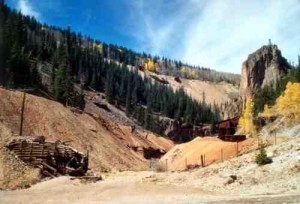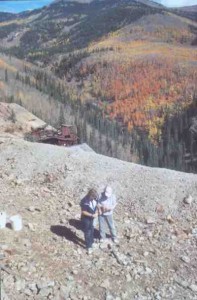Column by George Sibley
Water – July 2006 – Colorado Central Magazine
IT’S JULY, and time for my annual “water on the brain” column. As organizer of Western State College’s annual “Colorado Water Workshop” — now in its 31st year — water is about all I have on my mind these days, but water is a pretty interesting and relevant topic as we head into another “subnormal” summer, waterwise, in most of Colorado’s watersheds.
The theme of the conference this year is “The Developed Resource,” drawing from a fairly startling observation by Justice Greg Hobbs of the Colorado Supreme Court, as he closed last summer’s Water Workshop: “We are no longer developing the [water] resource; we are learning how to share a developed resource.”
Justice Hobbs was one of the state’s savvier water lawyers before Gov. Romer tapped him for the court, so it is an important enough observation to warrant starting this year’s Water Workshop right where last year’s left off. This year we’ll be exploring the implications of that “developed resource” for a state and region experiencing rapid growth.
I had of course barely put the teaser card for the conference in the mail back in April when Dave Miller called up from the Front Range saying that it isn’t true that our water is all developed, and it’s dangerous to say something so untrue because, according to Dave, we are still letting a million acre-feet or more of our Colorado River allotment escape the state, mostly from the Gunnison River, and we ought to be storing that undeveloped water in a big high-altitude reservoir up in Union Park, near the Divide between the Arkansas and Gunnison River Basins — pretty much in the center of Central Colorado.
Miller is of course not the only one who denies that Colorado has developed all of its water, but the million-acre-feet number melts fast under scrutiny. Eric Kuhn, manager of the Colorado River Water Conservation District (which oversees all of the Colorado River tributaries except the San Juan and Dolores in southwestern Colorado), laid out a more detailed set of numbers in mid-May, at a Montrose meeting of the four Western Slope watersheds in the Colorado River Basin.
According to Kuhn, when all existing uses, and all new projects already either under construction or in the permitting process, are subtracted from the anticipated supply, he estimates there might be between 250,000 and 300,000 acre-feet of water left in the Upper Colorado Basin for the whole state to develop — but that is only if the anticipated supply resembles the 20th century water supply, which 400-year paleohydrology studies indicate is unlikely, and if some kinds of ambiguous claims on the water are not “real,” like a Park Service claim for Gunnison Basin water to maintain the Black Canyon in its “natural” state, or water for the endangered Colorado River fish — et cetera.
We in the Upper Gunnison cannot but wince at the coincidence between Kuhn’s numbers for the amount of water left to develop in western Colorado, and the Supreme Court’s estimate in their “final” Union Park decision a few years ago. The court concluded that there wasn’t enough unappropriated water high in the Upper Gunnison watershed to make the Union Park reservoir feasible, but there might be a “marketable pool of 240,000 acre-feet” in Blue Mesa Reservoir. In effect, that closed the door on Dave Miller’s idea, then opened a really big window.
But whether our water resource is completely developed, or whether there are still dribs and drabs of unappropriated water here and there, what’s clear is that Justice Hobbs is right on the mark for the coming century: The challenge we took on in the 20th century was the large scale development of water, but the challenge for the 21st century will be learning how to best allocate developed water.
THE KIND OF COMPLEXITY this brings to the water picture lies in what I think of as the “water-energy-food equation.” Those are the three resources without which no human society can survive, and we tend to think of them in pretty independent ways. We need water enough to drink and keep things clean and green; food enough to keep the internal energy up; and energy resources sufficient to keep us warm and productive in carrying out the society’s work.
But those three essential resources are intimately linked — especially here in the West where all food production is from irrigated agriculture. Most of the “lost civilizations” around the world declined and fell as a result of some complex convergence of failures in their food, water and energy (wood) resources. We are undoubtedly the largest civilization that has ever stressed the earth, and it seems inconceivable that we would ever “disappear,” but we should take seriously the fact that we are talking about a suddenly finite water resource at the same time that even the petroleum companies are accepting “peak oil” as an unarguable fact. (“Peak oil” refers to the point at which global petroleum production ceases to be able to keep up with demand.)
Look at some of the connections. We consume huge amounts of water to produce energy — not through hydropower (which doesn’t “consume” the water) but for both the steam and cooling required in the production of most of our electricity: About 25 gallons of water are consumed for every kilowatt hour of coal-fired or nuclear power.
We then turn around and use a lot of that power to move water around. Water is probably still a net energy producer on its way to serve most urban and agricultural water users in the arid West, thanks to the huge hydro-electric plants here. But there are already some major power drains on the system. Power is consumed to keep water running through big ditches like the California Aqueduct and the Central Arizona Project, and to pump water out of the ground and on to its destination, which is an increasing drain, due to our growing dependence on (ever receding) groundwater. Imagine what a “Big Straw” project or a pipe from Blue Mesa to the Arkansas (and on to the South Platte) would do to the water-energy balance in Colorado. Most of the plans in the metro area to reuse water, share water with farmers, et cetera will require moving water against gravity, or cleaning and recleaning water, which also expends energy.
Furthermore, both water and energy are required for food production in the arid West. Large quantities of fossil-fuel are consumed in pumping groundwater to irrigate crops, and the chemicals essential to the yields our farmers achieve are also a heavy drain on our energy resources. Then we use even more fossil-fuel energy to move the food to market, which is no longer a matter of farmers waking up at four in the morning to load their wagons to go to market in a nearby city by dawn. Now most of our food has traveled hundreds of miles to get to us, wherever we are.
This is clearly a system that depends heavily on cheap water and cheap energy, and given our system’s stubborn faith in “market solutions,” there is reason to be apprehensive about a “developed resource,” because it means that Colorado’s water supply probably won’t be increasing, even though demands surely will.
In a context of developed resources, the rate at which Colorado’s population is growing should probably be considered alarming. So what’s to be done?
I’m trying to round up a bunch of water people who will at least have interesting ideas on that and the other challenges for Western’s Water Workshop July 26-28. You can follow this on the Web at www.western.edu/water, and some interesting papers will be posted there after the conference.
Aside from organizing the Western Water Workshop (did you think WWW stood for something else?), George Sibley teaches at Western State College in Gunnison.


